Spatial Distribution Characteristics and Risk Assessment of Nutrient Elements and Heavy Metals in the Ganjiang River Basin
Abstract
1. Introduction
2. Materials and Methods
2.1. Study Area
2.2. Sample Collection
2.3. Nemiro Comprehensive Pollution Index Method
2.4. Statistical Analysis
3. Results and Discussion
3.1. Element Discrete Analysis
3.2. Nutrient Element and Metal Element Characteristics in the Ganjiang River Basin
3.3. Water Environment Health Risk Assessment of the Ganjiang River Basin
3.4. Multivariate Statistical Analysis of Trace Elements
3.4.1. Principal Component Analysis
3.4.2. Cluster Analysis
3.4.3. Correlation Matrix
3.4.4. Source Identification of Heavy Metals and Nutrient Elements
4. Conclusions
Author Contributions
Funding
Institutional Review Board Statement
Informed Consent Statement
Data Availability Statement
Acknowledgments
Conflicts of Interests
Abbreviations
Appendix A
| Single Factor Pollution Index (Pi) | Pollution Level | Comprehensive Pollution Index (Pn) | Pollution Level |
|---|---|---|---|
| Pi ≤ 1 | Clean | Pn ≤ 1 | pollution-free |
| 1 < Pi ≤ 2 | Mild pollution | 1 < Pn ≤ 2 | Mild pollution |
| 2 < Pi≤3 | Moderate pollution | 2 < Pn ≤ 3 | Moderate pollution |
| Pi > 3 | Heavy pollution | Pn > 3 | Heavy pollution |
| Site | pH | DO | COD | BOD5 | NH4+-N | TP | TN | Cu | Zn | As | Cr | |
|---|---|---|---|---|---|---|---|---|---|---|---|---|
| mg·L−1 | µg·L−1 | |||||||||||
| Main stream | 7.12 | 7.04 | 10.34 | 2.11 | 0.44 | 0.13 | 0.62 | 69.60 | 16.12 | 0.04 | 6.36 | |
| Tributaries | Taojiang | 6.69 | 6.74 | 12.45 | 1.74 | 0.70 | 0.04 | 0.83 | 16.67 | 24.67 | 0.04 | 4.67 |
| Zhangshui | 6.99 | 6.41 | 9.01 | 1.99 | 0.68 | 0.10 | 0.85 | 18.00 | 44.00 | 0.13 | 3.80 | |
| Shangyoujiang | 6.93 | 6.22 | 10.14 | 1.64 | 0.40 | 0.05 | 0.59 | 17.50 | 35.25 | 0.00 | 2.50 | |
| Heshui | 7.13 | 6.71 | 6.52 | 1.28 | 0.21 | 0.10 | 0.54 | 31.25 | 35.25 | 0.15 | 6.50 | |
| Lushui | 6.99 | 7.13 | 5.60 | 0.99 | 0.12 | 0.05 | 0.35 | 0.00 | 4.40 | 0.23 | 3.60 | |
| Yuanshui | 6.94 | 6.54 | 7.39 | 1.56 | 0.42 | 0.07 | 0.67 | 33.75 | 7.75 | 0.08 | 7.13 | |
| Jinjiang | 6.92 | 6.48 | 10.43 | 2.11 | 0.57 | 0.24 | 0.82 | 41.27 | 11.00 | 0.26 | 6.64 | |
| Enjiang | 6.99 | 6.30 | 7.39 | 1.34 | 0.20 | 0.10 | 0.71 | 0.00 | 23.75 | 0.48 | 8.00 | |
| Gujiang | 7.11 | 6.70 | 11.14 | 1.48 | 0.34 | 0.11 | 0.49 | 12.00 | 21.80 | 0.06 | 2.40 | |
| Meijiang | 6.81 | 6.77 | 9.33 | 1.63 | 0.19 | 0.06 | 0.32 | 31.11 | 36.33 | 0.08 | 4.00 | |
| Yangtze River Background Value | 3.01 | 6.46 | 3.32 | 12.6 | ||||||||
| WHO a | 6.5–8.5 | 3.0 | 0.5 | 0.2 | 2000 | 10 | 50 | |||||
| China(GB5749-2006) a | 6–9 | 5.0 | 20 | 4 | 1 | 0.2 | 1 | 1000 | 1000 | 10 | 50 | |
| Noncarcinogen | RFDi/[mg·(kg·d)−1] | Carcinogen | qi/[mg·(kg·d)−1] |
|---|---|---|---|
| Cu | 0.005 | As | 15 |
| Zn | 0.3 | Cr | 41 |
| Site | Main Stream | Tributary | |||||||||||
|---|---|---|---|---|---|---|---|---|---|---|---|---|---|
| Upper Reach | Middle Reach | Lower Reach | Taojiang | Zhangshui | Shang youjiang | Heshui | Lushui | Yuanshui | Jinjiang | Enjiang | Gujiang | Meijiang | |
| Pn | 0.158 | 0.066 | 0.125 | 0.087 | 0.121 | 0.036 | 0.123 | 0.057 | 0.115 | 0.113 | 0.118 | 0.05 | 0.071 |
| T | pH | DO | COD | BOD5 | NH4+-N | TP | TN | Cu | Zn | As | Cr | |
|---|---|---|---|---|---|---|---|---|---|---|---|---|
| T | 1 | |||||||||||
| pH | 0.111 | 1 | ||||||||||
| DO | 0.116 | 0.22 * | 1 | |||||||||
| COD | −0.24 * | −0.27 ** | −0.28 ** | 1 | ||||||||
| BOD5 | −0.36 ** | −0.024 | 0.029 | 0.28 ** | 1 | |||||||
| NH4+-N | −0.37 ** | −0.20 * | −0.34 ** | 0.54 ** | 0.363 ** | 1 | ||||||
| TP | −0.23 * | −0.032 | −0.134 | 0.114 | 0.109 | 0.32 ** | 1 | |||||
| TN | −0.35 ** | −0.186 | −0.38 ** | 0.51 ** | 0.35 ** | 0.95 ** | 0.32 ** | 1 | ||||
| Cu | −0.099 | −0.144 | 0.168 | 0.067 | 0.35 ** | 0.28 ** | 0.26 ** | 0.27 ** | 1 | |||
| Zn | −0.042 | −0.178 | 0.025 | 0.012 | −0.015 | 0.058 | −0.064 | 0.038 | 0.39 ** | 1 | ||
| As | −0.078 | 0.002 | −0.046 | −0.079 | −0.03 | −0.09 | 0.058 | 0.063 | −0.071 | −0.031 | 1 | |
| Cr | −0.15 | 0.045 | −0.056 | 0.138 | 0.276 ** | 0.292 ** | 0.196 * | 0.341 ** | 0.203 * | −0.029 | 0.105 | 1 |
References
- Ishida, S.; Tsuchihara, T.; Imaizumi, M. Fluctuation of NO3-N in groundwater of the reservoir of the Sunagawa Subsurface Dam, Miyako Island, Japan. Paddy Water Environ. 2006, 4, 101–110. [Google Scholar] [CrossRef]
- Zhang, R.; Li, H.X.; Wu, X.F. Current Situation Analysis on China Rural Drinking Water Quality. J. Environ. Health 2009, 26, 3–5. [Google Scholar]
- Wu, H.; Xu, C.; Wang, J.; Xiang, Y.; Ren, M.; Qie, H.; Zhang, Y.; Yao, R.; Li, L.; Lin, A. Health risk assessment based on source identification of heavy metals: A case study of Beiyun River, China. Ecotoxicol. Environ. Saf. 2021, 213, 112046. [Google Scholar] [CrossRef]
- Qiu, Y.-W. Bioaccumulation of heavy metals both in wild and mariculture food chains in Daya Bay, South China. Estuar. Coast. Shelf Sci. 2015, 163, 7–14. [Google Scholar] [CrossRef]
- Liu, X.; Lu, Q.; Zhou, Y.; Li, K.; Xu, Y.; Lv, Q.; Qin, J.; Ouyang, S.; Wu, X. Community characteristics of phytoplankton and management implications in Poyang Lake Basin. Limnology 2020, 21, 207–218. [Google Scholar] [CrossRef]
- Zhang, D.W.; Zhang, L.; He, J.H.; Luo, L.G.; Wei, Y.H. Spatial distributions and risk assessment of dissolved heavy metals in Poyang Lake. Acta Ecol. Sin. 2015, 35, 8028–8035. [Google Scholar]
- Li, W.; Yang, Z.; Zhou, L.; Tang, M.; Yuan, G.; Liu, C. Geochemical Characteristic and Fluxes of Heavy Metals in Water System of the Poyang Lake. Geoscience 2014, 28, 512. [Google Scholar] [CrossRef]
- Li, T.; Yi, W.; Fu, Q.; Li, H.; Liu, Y.; Wu, Z.; Zheng, B. Load Estimation of Non-Point Heavy Metal Pollution in Beijiang River during Extreme Storm Runoff Event. Res. Environ. Sci. 2014, 27, 990–997. [Google Scholar]
- Yidana, S.M.; Ophori, D.; Banoeng-Yakubo, B.K. A multivariate statistical analysis of surface water chemistry data—The Ankobra Basin, Ghana. J. Environ. Manag. 2008, 86, 80–87. [Google Scholar] [CrossRef] [PubMed]
- Vega, M.; Pardo, R.; Barrado, E.; Debán, L. Assessment of seasonal and polluting effects on the quality of river water by exploratory data analysis. Water Res. 1998, 32, 3581–3592. [Google Scholar] [CrossRef]
- López, J.A.L.; Vargas, M.G.; Moreno, C. A chemometric approach to the evaluation of atmospheric and fluvial pollutant inputs in aquatic systems: The Guadalquivir River estuary as a case study. Environ. Pollut. 2011, 159, 1136–1143. [Google Scholar] [CrossRef]
- Salim, I.; Sajjad, R.U.; Paule-Mercado, M.C.; Memon, S.A.; Lee, B.-Y.; Sukhbaatar, C.; Lee, C.-H. Comparison of two receptor models PCA-MLR and PMF for source identification and apportionment of pollution carried by runoff from catchment and sub-watershed areas with mixed land cover in South Korea. Sci. Total Environ. 2019, 663, 764–775. [Google Scholar] [CrossRef] [PubMed]
- Varol, M. Dissolved heavy metal concentrations of the Kralkızı, Dicle and Batman dam reservoirs in the Tigris River basin, Turkey. Chemosphere 2013, 93, 954–962. [Google Scholar] [CrossRef]
- Krishna, A.K.; Satyanarayanan, M.; Govil, P.K. Assessment of heavy metal pollution in water using multivariate statistical techniques in an industrial area: A case study from Patancheru, Medak District, Andhra Pradesh, India. J. Hazard. Mater. 2009, 167, 366–373. [Google Scholar] [CrossRef]
- Wang, P.; Liu, J.; Qi, S.; Wang, S.; Chen, X. Tracing sources of nitrate using water chemistry, land use and nitrogen isotopes in the Ganjiang River, China. Isot. Environ. Health Stud. 2017, 53, 539–551. [Google Scholar] [CrossRef]
- Yong, J.; Jie, Z.; Huang, X.; Bai, C.; Chen, X. Investigation and assessment of heavy metals in surface sediments of Ganjiang River, China. J. Environ. Biol. 2014, 35, 1173–1179. [Google Scholar]
- Li, Y.; Kuang, H.; Hu, C.; Ge, G. Source Apportionment of Heavy Metal Pollution in Agricultural Soils around the Poyang Lake Region Using UNMIX Model. Sustainability 2021, 13, 5272. [Google Scholar] [CrossRef]
- Hu, M.; Wang, C.; Liu, Y.; Zhang, X.; Jian, S. Fish species composition, distribution and community structure in the lower reaches of Ganjiang River, Jiangxi, China. Sci. Rep. 2019, 9, 10100. [Google Scholar] [CrossRef]
- Chu, X.; Wang, H.; Zheng, F.; Huang, C.; Xu, C.; Wu, D. Spatial Distribution Characteristics and Sources of Nutrients and Heavy Metals in the Xiujiang River of Poyang Lake Basin in the Dry Season. Water 2021, 13, 1654. [Google Scholar] [CrossRef]
- WHO. Guidelines for Drinking-Water Quality, 4th, ed.; WHO: Geneva, Switzerland, 2011. [Google Scholar]
- Gibbs, R.J. Mechanisms Controlling World Water Chemistry. Science 1970, 170, 1088–1090. [Google Scholar] [CrossRef] [PubMed]
- Galambos, I.; Molina, J.M.; Járay, P.; Vatai, G.; Bekássy-Molnár, E. High organic content industrial wastewater treatment by membrane filtration. Desalination 2004, 162, 117–120. [Google Scholar] [CrossRef]
- Franken, G.; Postma, D.; Duijnisveld, W.H.; Böttcher, J.; Molson, J. Acid groundwater in an anoxic aquifer: Reactive transport modelling of buffering processes. Appl. Geochem. 2009, 24, 890–899. [Google Scholar] [CrossRef]
- Le, S.K.; Pan, J.Y.; Chen, Y.P.; Yan, Z.B. Study on sulfur isotopes in rain water and lake water in Nanchang city. Earth Environ. 2007, 35, 297–302. [Google Scholar]
- Yang, Q.; Liu, Z.; Yang, J. Simultaneous Determination of Chemical Oxygen Demand (COD) and Biological Oxygen Demand (BOD5) in Wastewater by Near-Infrared Spectrometry. J. Water Resour. Prot. 2009, 1, 286–289. [Google Scholar] [CrossRef][Green Version]
- Xiang, S.L.; Wang, Q.J.; Xu, L.-K.; Nie, F.H. Nitrogen & Phosphorus Loading and Migration of Farmland Ditch Runoff in Ganjiang River. J. Henan Agric. Sci. 2012, 41, 72–74. Available online: http://en.cnki.com.cn/Article_en/CJFDTOTAL-HNNY201203020.htm (accessed on 27 November 2021). (In Chinese).
- Pekey, H.; Karakaş, D.; Bakoglu, M. Source apportionment of trace metals in surface waters of a polluted stream using multivariate statistical analyses. Mar. Pollut. Bull. 2004, 49, 809–818. [Google Scholar] [CrossRef]
- Liang, B.; Han, G.; Liu, M.; Yang, K.; Li, X.; Liu, J. Distribution, Sources, and Water Quality Assessment of Dissolved Heavy Metals in the Jiulongjiang River Water, Southeast China. Int. J. Environ. Res. Public Health 2018, 15, 2752. [Google Scholar] [CrossRef] [PubMed]
- Gao, L.; Chen, J.; Tang, C.; Ke, Z.; Wang, J.; Shimizu, Y.; Zhu, A. Distribution, migration and potential risk of heavy metals in the Shima River catchment area, South China. Environ. Sci. Process. Impacts 2015, 17, 1769. [Google Scholar] [CrossRef]
- Wan, Z.; Chen, X.; Ju, M.; Ling, C.; Liu, G.; Lin, S.; Liu, H.; Jia, Y.; Jiang, M.; Liao, F. Streamflow Reconstruction and Variation Characteristic Analysis of the Ganjiang River in China for the Past 515 Years. Sustainability 2020, 12, 1168. [Google Scholar] [CrossRef]
- Zhang, Y.Q.; Xiang, Y.; Chen, C.C.; Wei, R.C. Research on spatial-temporal variation of drought and flood events over Ganjiang basin. J. Meteorol. Sci. 2015, 35, 346–352. (In Chinese) [Google Scholar] [CrossRef]
- Zhang, H.; Jiang, Y.; Wang, M.; Wang, P.; Shi, G.; Ding, M. Spatial characterization, risk assessment, and statistical source identification of the dissolved trace elements in the Ganjiang River—Feeding tributary of the Poyang Lake, China. Environ. Sci. Pollut. Res. 2016, 24, 2890–2903. [Google Scholar] [CrossRef]
- Liu, Y.; Ma, Z.; Lv, J.; Bi, J. Identifying sources and hazardous risks of heavy metals in topsoils of rapidly urbanizing East China. J. Geogr. Sci. 2016, 26, 735–749. [Google Scholar] [CrossRef]
- Alexander, R.B.; Smith, R.A.; Schwarz, G.E.; Boyer, E.W.; Nolan, J.V.; Brakebill, J.W. Differences in Phosphorus and Nitrogen Delivery to the Gulf of Mexico from the Mississippi River Basin. Environ. Sci. Technol. 2007, 42, 822–830. [Google Scholar] [CrossRef]
- Åström, M. Abundance and fractionation patterns of rare earth elements in streams affected by acid sulphate soils. Chem. Geol. 2001, 175, 249–258. [Google Scholar] [CrossRef]
- Rinklebe, J.; Antoniadis, V.; Shaheen, S.M.; Rosche, O.; Altermann, M. Health risk assessment of potentially toxic elements in soils along the Central Elbe River, Germany. Environ. Int. 2019, 126, 76–88. [Google Scholar] [CrossRef]
- Mukherjee, I.; Singh, U.K.; Singh, R.P.; Kumari, D.; Jha, P.K.; Mehta, P. Characterization of heavy metal pollution in an anthropogenically and geologically influenced semi-arid region of east India and assessment of ecological and human health risks. Sci. Total. Environ. 2019, 705, 135801. [Google Scholar] [CrossRef]
- Rodriguez, R.R.; Basta, N.T.; Casteel, S.W.; Pace, L.W. An in Vitro Gastrointestinal Method to Estimate Bioavailable Arsenic in Contaminated Soils and Solid Media. Environ. Sci. Technol. 1999, 33, 642–649. [Google Scholar] [CrossRef]
- Bu, H.; Wang, W.; Song, X.; Zhang, Q. Characteristics and source identification of dissolved trace elements in the Jinshui River of the South Qinling Mts., China. Environ. Sci. Pollut. Res. 2015, 22, 14248–14257. [Google Scholar] [CrossRef]
- Giri, S.; Singh, A.K. Risk assessment, statistical source identification and seasonal fluctuation of dissolved metals in the Subarnarekha River, India. J. Hazard. Mater. 2014, 265, 305–314. [Google Scholar] [CrossRef] [PubMed]
- Krishna, A.K.; Mohan, K.R. Risk assessment of heavy metals and their source distribution in waters of a contaminated industrial site. Environ. Sci. Pollut. Res. 2013, 21, 3653–3669. [Google Scholar] [CrossRef] [PubMed]
- Varol, M. Assessment of heavy metal contamination in sediments of the Tigris River (Turkey) using pollution indices and multivariate statistical techniques. J. Hazard. Mater. 2011, 195, 355–364. [Google Scholar] [CrossRef]
- Buzier, R.; Tusseau-Vuillemin, M.-H.; Meriadec, C.M.D.; Rousselot, O.; Mouchel, J.-M. Trace metal speciation and fluxes within a major French wastewater treatment plant: Impact of the successive treatments stages. Chemosphere 2006, 65, 2419–2426. [Google Scholar] [CrossRef] [PubMed]
- Micó, C.; Recatalá, L.; Peris, M.; Sánchez, J. Assessing heavy metal sources in agricultural soils of an European Mediterranean area by multivariate analysis. Chemosphere 2006, 65, 863–872. [Google Scholar] [CrossRef] [PubMed]
- Wang, X.-L.; Lu, Y.-L.; Han, J.-Y.; He, G.-Z.; Wang, T.-Y. Identification of anthropogenic influences on water quality of rivers in Taihu watershed. J. Environ. Sci. 2007, 19, 475–481. [Google Scholar] [CrossRef]
- Taneez, M.; Marmier, N.; Hurel, C. Use of neutralized industrial residue to stabilize trace elements (Cu, Cd, Zn, As, Mo, and Cr) in marine dredged sediment from South-East of France. Chemosphere 2016, 150, 116–122. [Google Scholar] [CrossRef]
- Zhao, G.; Ye, S.; Yuan, H.; Ding, X.; Wang, J.; Laws, E.A. Surface sediment properties and heavy metal contamination assessment in river sediments of the Pearl River Delta, China. Mar. Pollut. Bull. 2018, 136, 300–308. [Google Scholar] [CrossRef] [PubMed]
- Qu, L.; Huang, H.; Xia, F.; Liu, Y.; Dahlgren, R.; Zhang, M.; Mei, K. Risk analysis of heavy metal concentration in surface waters across the rural-urban interface of the Wen-Rui Tang River, China. Environ. Pollut. 2018, 237, 639–649. [Google Scholar] [CrossRef] [PubMed]
- Cheung, K.; Poon, B.; Lan, C.; Wong, M. Assessment of metal and nutrient concentrations in river water and sediment collected from the cities in the Pearl River Delta, South China. Chemosphere 2003, 52, 1431–1440. [Google Scholar] [CrossRef]
- Huang, S.; Liao, Q.; Hua, M.; Wu, X.; Bi, K.; Yan, C.; Chen, B.; Zhang, X. Survey of heavy metal pollution and assessment of agricultural soil in Yangzhong district, Jiangsu Province, China. Chemosphere 2007, 67, 2148–2155. [Google Scholar] [CrossRef]
- Neal, C.; Neal, M.; Hill, L.; Wickham, H. The water quality of the River Thame in the Thames Basin of south/south-eastern England. Sci. Total. Environ. 2006, 360, 254–271. [Google Scholar] [CrossRef] [PubMed]
- Casado-Martínez, M.; Forja, J.; Del Valls, T. A multivariate assessment of sediment contamination in dredged materials from Spanish ports. J. Hazard. Mater. 2009, 163, 1353–1359. [Google Scholar] [CrossRef]
- Li, J.; He, M.; Han, W.; Gu, Y. Analysis and assessment on heavy metal sources in the coastal soils developed from alluvial deposits using multivariate statistical methods. J. Hazard. Mater. 2009, 164, 976–981. [Google Scholar] [CrossRef] [PubMed]
- Toro, P.P.V.; Bedoya, L.F.V.; Correa, I.D.; Franco, G.R.B.; Alcántara-Carrió, J.; Baena, J.A.P. Impact of terrestrial mining and intensive agriculture in pollution of estuarine surface sediments: Spatial distribution of trace metals in the Gulf of Urabá, Colombia. Mar. Pollut. Bull. 2016, 111, 311–320. [Google Scholar] [CrossRef] [PubMed]
- Lu, X.; Wang, L.; Li, L.Y.; Lei, K.; Huang, L.; Kang, D. Multivariate statistical analysis of heavy metals in street dust of Baoji, NW China. J. Hazard. Mater. 2010, 173, 744–749. [Google Scholar] [CrossRef] [PubMed]
- Saeedi, M.; Li, L.; Zadeh, M. Heavy metals and polycyclic aromatic hydrocarbons: Pollution and ecological risk assessment in street dust of Tehran. J. Hazard. Mater. 2012, 227–228, 9–17. [Google Scholar] [CrossRef]
- Kidd, P.; Domínguez-Rodríguez, M.; Díez, J.; Monterroso, C. Bioavailability and plant accumulation of heavy metals and phosphorus in agricultural soils amended by long-term application of sewage sludge. Chemosphere 2007, 66, 1458–1467. [Google Scholar] [CrossRef] [PubMed]
- Kim, I.-G.; Kim, Y.-B.; Kim, R.-H.; Hyon, T.-S. Spatial distribution, origin and contamination assessment of heavy metals in surface sediments from Jangsong tidal flat, Kangryong river estuary, DPR Korea. Mar. Pollut. Bull. 2021, 168, 112414. [Google Scholar] [CrossRef] [PubMed]
- Fan, J.; Jian, X.; Shang, F.; Zhang, W.; Zhang, S.; Fu, H. Underestimated heavy metal pollution of the Minjiang River, SE China: Evidence from spatial and seasonal monitoring of suspended-load sediments. Sci. Total Environ. 2020, 760, 142586. [Google Scholar] [CrossRef] [PubMed]
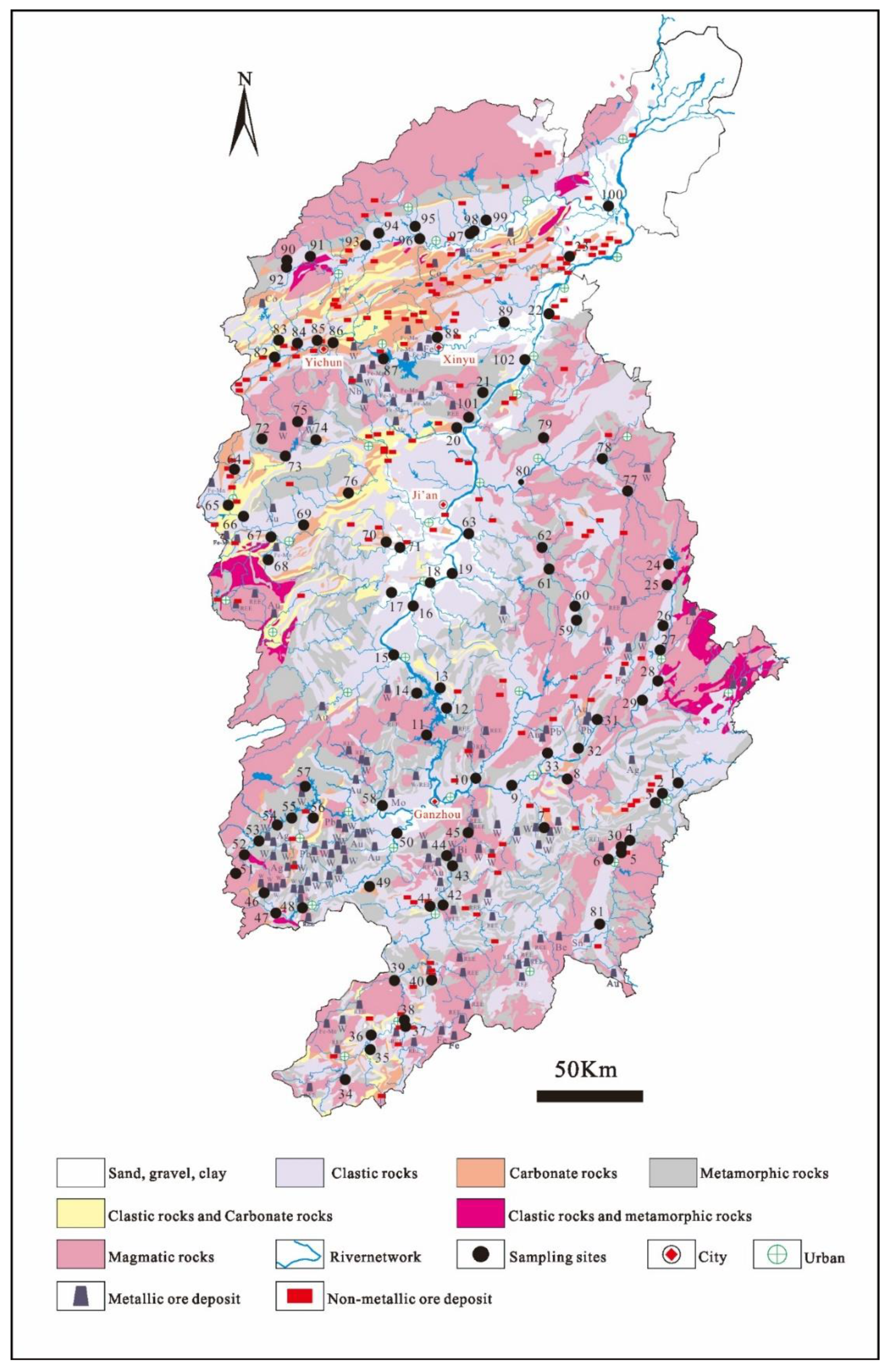

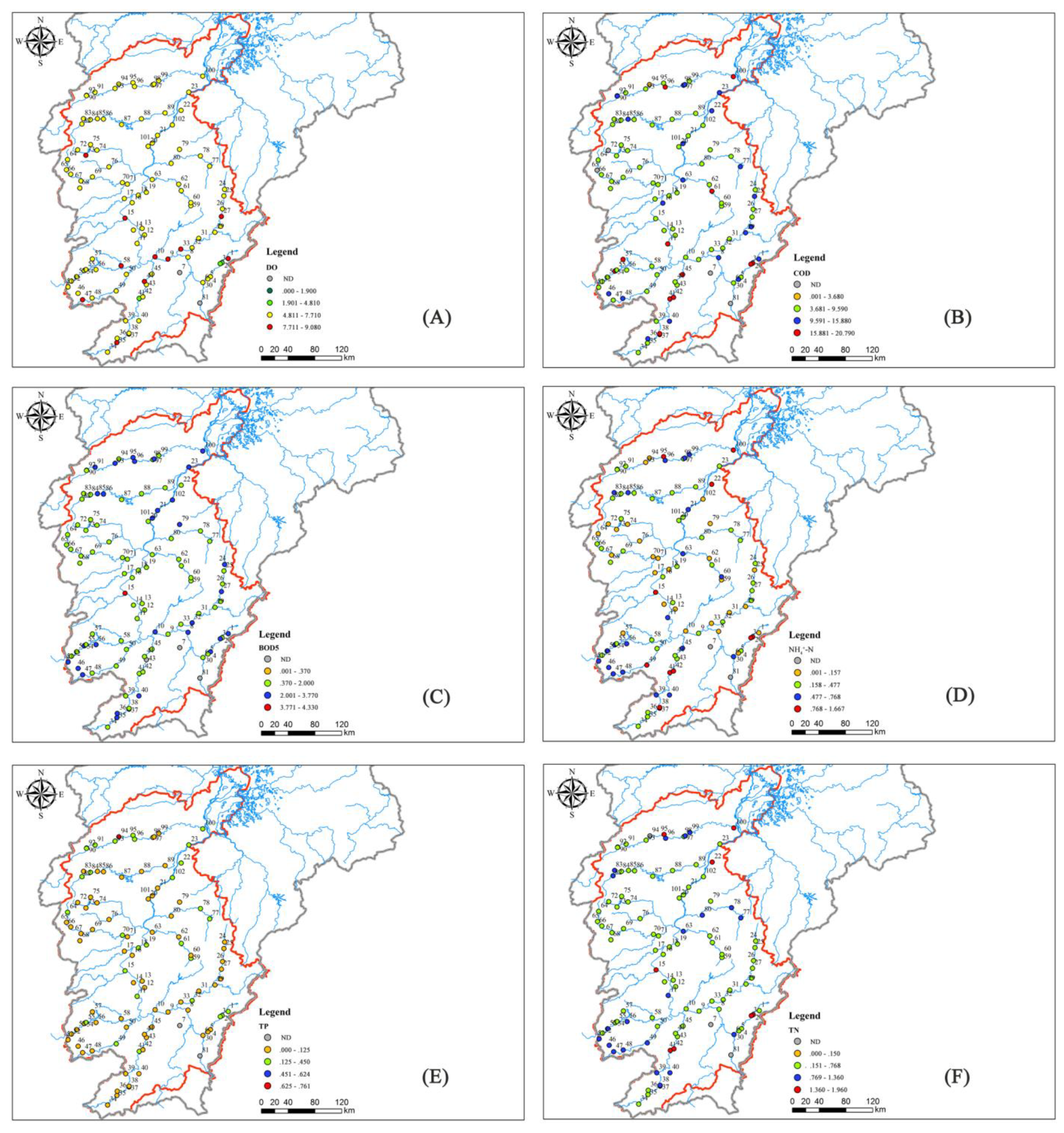
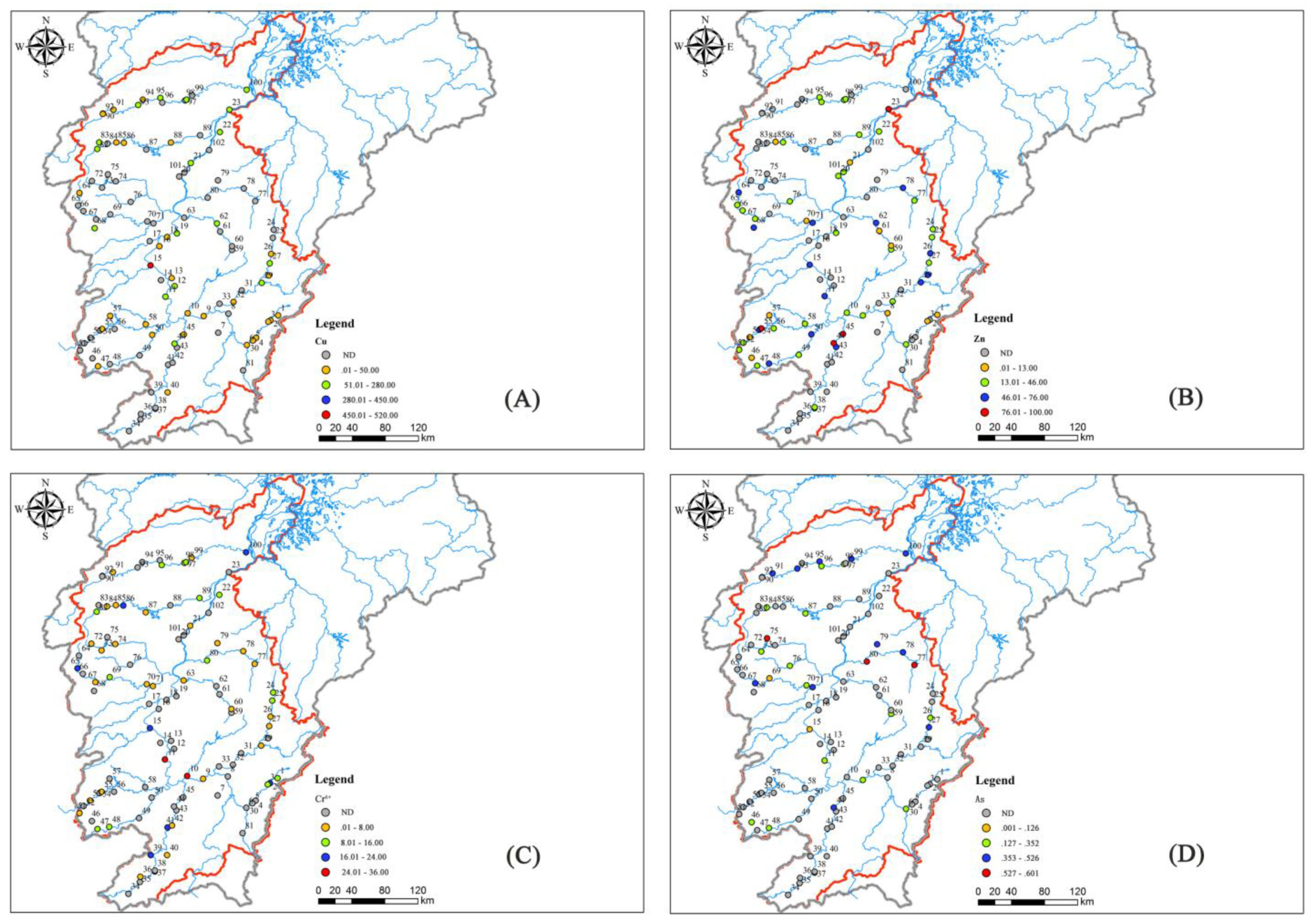
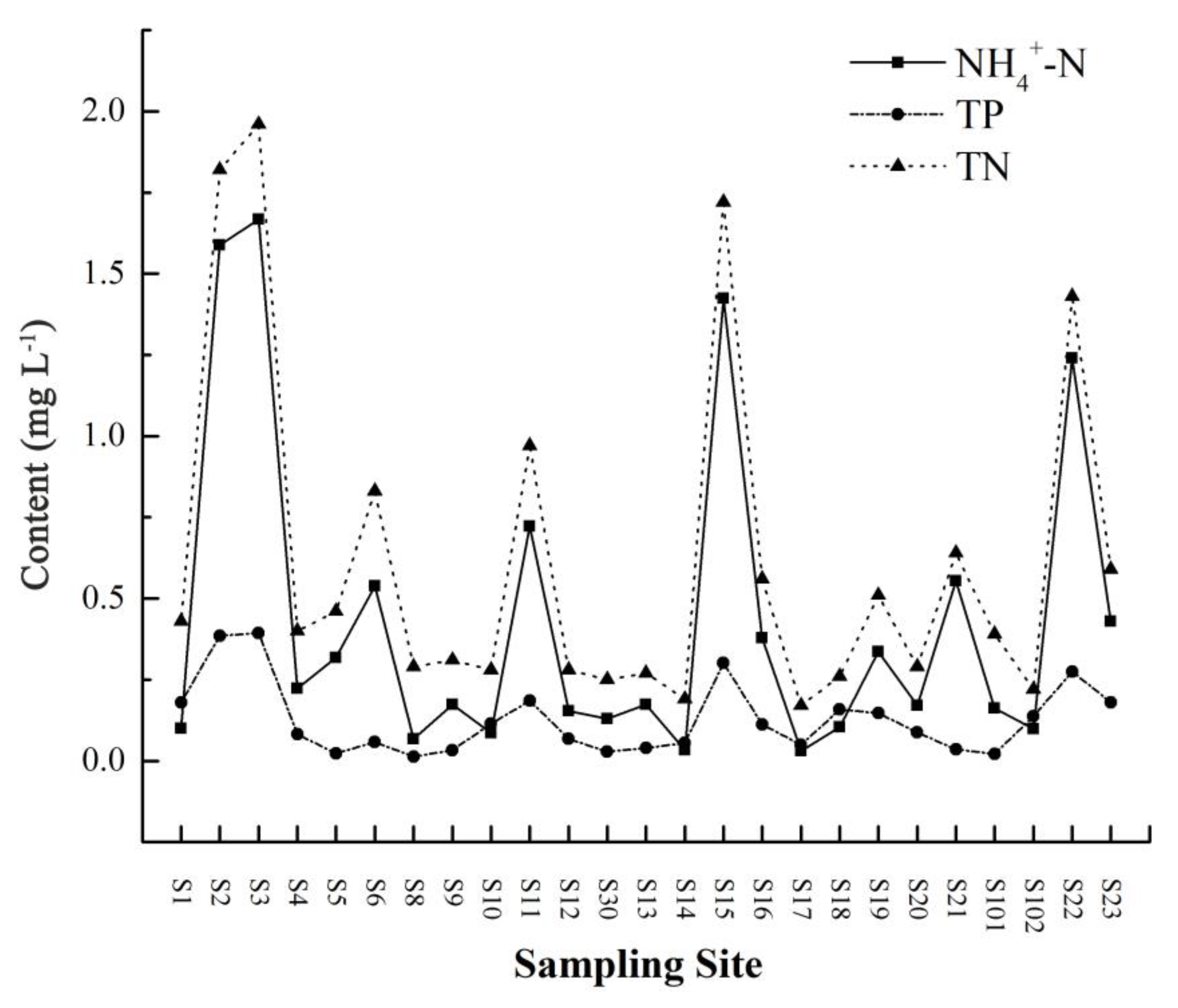

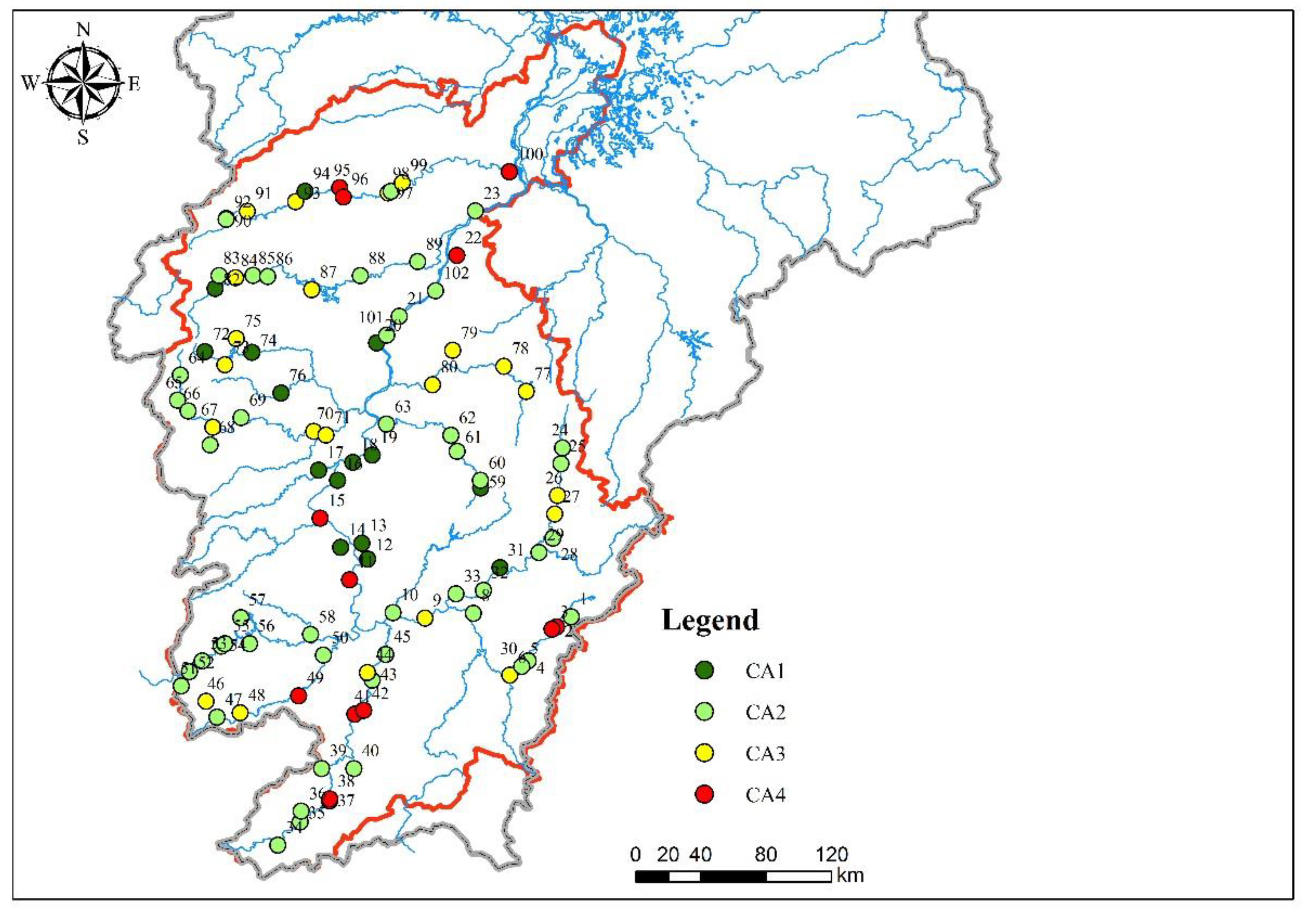
| Reach | Value | pH | DO | COD | BOD5 | NH4+-N | TP | TN | Cu | Zn | Cr | As |
|---|---|---|---|---|---|---|---|---|---|---|---|---|
| mg·L−1 | µg·L−1 | |||||||||||
| Upper reach | Max | 7.47 | 9.06 | 20.79 | 3.77 | 1.67 | 0.39 | 1.96 | 250 | 50 | 40 | 0.35 |
| Min | 6.87 | 4.1 | 6.19 | 0.93 | 0.07 | 0.01 | 0.25 | 0 | 0 | 0 | 0 | |
| Mean | 7.16 | 7.03 | 11.31 | 2.31 | 0.48 | 0.13 | 0.69 | 58.33 | 11.58 | 9.75 | 0.08 | |
| Mean square error | 0.19 | 1.54 | 4.42 | 0.90 | 0.55 | 0.13 | 0.58 | 61.49 | 14.06 | 12.15 | 0.14 | |
| RSD | 0.03 | 0.23 | 0.39 | 0.39 | 1.14 | 0.98 | 0.84 | 1.05 | 1.21 | 1.25 | 1.73 | |
| Counts | 12 | 12 | 12 | 12 | 12 | 12 | 12 | 12 | 12 | 12 | 12 | |
| Middle reach | Max | 7.67 | 8.13 | 14.57 | 4.33 | 1.42 | 0.3 | 1.72 | 520 | 70 | 20 | 0.03 |
| Min | 6.4 | 6.52 | 6.68 | 1 | 0.03 | 0.04 | 0.19 | 0 | 0 | 0 | 0 | |
| Mean | 7.08 | 7.07 | 9.06 | 1.85 | 0.34 | 0.1 | 0.5 | 78.00 | 14.40 | 2.70 | 0.00 | |
| Mean square error | 0.40 | 0.50 | 2.13 | 0.94 | 0.39 | 0.08 | 0.43 | 149.45 | 20.99 | 6.36 | 0.01 | |
| RSD | 0.06 | 0.07 | 0.24 | 0.51 | 1.17 | 0.80 | 0.87 | 1.92 | 1.46 | 2.35 | 3.00 | |
| Counts | 10 | 10 | 10 | 10 | 10 | 10 | 10 | 10 | 10 | 10 | 10 | |
| Lower reach | Max | 7.33 | 7.48 | 12.15 | 2.57 | 1.24 | 0.28 | 1.43 | 200 | 100 | 20 | 0 |
| Min | 6.83 | 6.25 | 8.68 | 1.83 | 0.1 | 0.14 | 0.22 | 0 | 0 | 0 | 0 | |
| Mean | 7.08 | 6.95 | 10.7 | 2.14 | 0.59 | 0.20 | 0.75 | 86.67 | 40.00 | 5.00 | 0.00 | |
| Mean square error | 0.20 | 0.52 | 1.47 | 0.31 | 0.48 | 0.06 | 0.51 | 83.80 | 43.20 | 7.07 | 0.00 | |
| RSD | 0.03 | 0.07 | 0.14 | 0.15 | 0.81 | 0.29 | 0.68 | 0.97 | 1.08 | 1.41 | ||
| Counts | 3 | 3 | 3 | 3 | 3 | 3 | 3 | 3 | 3 | 3 | 3 | |
| Tributaries | Max | 8.27 | 9.08 | 20.5 | 3.63 | 1.55 | 0.76 | 1.63 | 80 | 90 | 20 | 0.6 |
| Min | 6.03 | 4.23 | 0 | 0 | 0.09 | 0.01 | 0 | 0 | 0 | 0 | 0 | |
| Mean | 6.93 | 6.65 | 9.48 | 1.64 | 0.42 | 0.1 | 0.63 | 22.2 | 24.2 | 5.8 | 0.13 | |
| Mean square error | 0.30 | 1.13 | 3.55 | 0.89 | 0.49 | 0.11 | 0.53 | 108.24 | 23.97 | 10.20 | 0.11 | |
| RSD | 0.04 | 0.16 | 0.34 | 0.42 | 1.13 | 0.86 | 0.85 | 1.56 | 1.49 | 1.60 | 2.62 | |
| Counts | 75 | 75 | 75 | 75 | 75 | 75 | 75 | 75 | 75 | 75 | 75 | |
| Ganjiang River Basin | Noncarcinogen Risk | Carcinogen Risk | Rtotal (10−6) | ||||||||
|---|---|---|---|---|---|---|---|---|---|---|---|
| Cu (10−9) | Zn (10−11) | As (10−6) | Cr (10−6) | ||||||||
| Adults | Children | Adults | Children | Adults | Children | Adults | Children | Adults | Children | ||
| Main stream | Upper reach | 5.39 | 6.88 | 1.79 | 2.28 | 0.57 | 0.73 | 181.65 | 230.73 | 182.22 | 231.47 |
| Middle reach | 7.21 | 9.21 | 2.22 | 2.83 | 0.02 | 0.03 | 50.55 | 64.30 | 50.58 | 64.34 | |
| Lower reach | 8.01 | 10.23 | 6.16 | 7.87 | 0.00 | 0.00 | 93.79 | 119.36 | 93.80 | 119.37 | |
| Tributary | Taojiang | 1.54 | 1.97 | 3.80 | 4.85 | 0.24 | 0.31 | 87.40 | 111.19 | 87.65 | 111.50 |
| Zhangshui | 1.66 | 2.12 | 6.78 | 8.65 | 0.87 | 1.11 | 71.56 | 91.16 | 72.43 | 92.27 | |
| Shangyoujiang | 1.62 | 2.07 | 5.43 | 6.93 | 0.00 | 0.00 | 47.17 | 60.12 | 47.17 | 60.13 | |
| Heshui | 2.89 | 3.69 | 5.43 | 6.93 | 1.06 | 1.35 | 121.98 | 155.24 | 123.04 | 156.60 | |
| Lushui | 0.00 | 0.00 | 0.68 | 0.87 | 1.60 | 2.05 | 67.94 | 86.61 | 69.55 | 88.65 | |
| Yuanshui | 3.12 | 3.98 | 1.19 | 1.52 | 0.56 | 0.71 | 133.86 | 170.42 | 134.42 | 171.14 | |
| Jinjiang | 3.82 | 4.87 | 1.70 | 2.16 | 1.81 | 2.31 | 124.63 | 158.66 | 126.45 | 160.97 | |
| Enjiang | 0.00 | 0.00 | 3.66 | 4.67 | 3.35 | 4.28 | 150.63 | 191.89 | 153.98 | 196.17 | |
| Gujiang | 1.11 | 1.42 | 3.36 | 4.29 | 0.43 | 0.55 | 45.30 | 57.75 | 45.73 | 58.30 | |
| Meijiang | 2.88 | 3.67 | 5.60 | 7.15 | 0.58 | 0.74 | 75.37 | 96.04 | 75.95 | 96.78 | |
| Component | Initial Eigenvalue | Rotating Load Sum of Squares | |||||
|---|---|---|---|---|---|---|---|
| Total | Variance % | Cumulative % | Total | Variance % | Cumulative % | ||
| T | 3.422 | 28.516 | 28.516 | 2.620 | 21.831 | 21.831 | |
| pH | 1.512 | 12.596 | 41.113 | 2.152 | 17.930 | 39.761 | |
| DO | 1.350 | 11.252 | 52.365 | 1.465 | 12.209 | 51.971 | |
| COD | 1.081 | 9.008 | 61.373 | 1.128 | 9.402 | 61.373 | |
| BOD5 | 0.939 | 7.822 | 69.195 | ||||
| NH4+-N | 0.859 | 7.161 | 76.356 | ||||
| TP | 0.738 | 6.154 | 82.510 | ||||
| TN | 0.654 | 5.447 | 87.957 | ||||
| Cu | 0.567 | 4.728 | 92.685 | ||||
| Zn | 0.509 | 4.239 | 96.924 | ||||
| As | 0.333 | 2.777 | 99.700 | ||||
| Cr | 0.036 | 0.300 | 100.000 | ||||
| Variable | Rotated Component Matrix a | Extract | |||||
| PC1 | PC2 | PC3 | PC4 | ||||
| T | −0.513 | −0.222 | −0.026 | −0.060 | 0.317 | ||
| pH | 0.143 | −0.567 | −0.469 | −0.043 | 0.563 | ||
| DO | 0.016 | −0.754 | 0.151 | −0.198 | 0.631 | ||
| COD | 0.305 | 0.641 | −0.004 | −0.296 | 0.591 | ||
| BOD5 | 0.682 | −0.043 | 0.068 | −0.309 | 0.567 | ||
| NH4+-N | 0.647 | 0.617 | 0.077 | −0.177 | 0.836 | ||
| TP | 0.511 | 0.108 | 0.038 | 0.289 | 0.357 | ||
| TN | 0.666 | 0.613 | 0.058 | −0.031 | 0.824 | ||
| Cu | 0.477 | −0.166 | 0.707 | −0.119 | 0.769 | ||
| Zn | −0.079 | 0.032 | 0.839 | 0.018 | 0.711 | ||
| As | 0.111 | −0.021 | −0.024 | 0.863 | 0.758 | ||
| Cr | 0.638 | −0.059 | −0.055 | 0.161 | 0.440 | ||
| Component | Clustering | ||||||||||
|---|---|---|---|---|---|---|---|---|---|---|---|
| CA1 (n = 15) | CA2 (n = 50) | CA3 (n = 22) | CA4 (n = 13) | Significance Test df = 3 | |||||||
| Mean | SD | Mean | SD | Mean | SD | Mean | SD | MS | F | P | |
| T | 13.74 | 1.11 | 11.81 | 0.52 | 12.05 | 0.80 | 11.42 | 0.77 | 0.55 | 0.52 | 0.47 |
| pH | 7.03 | 0.36 | 6.99 | 0.41 | 6.99 | 0.30 | 6.77 | 0.42 | 0.30 | 2.03 | 0.16 |
| DO | 6.81 | 0.62 | 6.81 | 0.99 | 6.75 | 0.95 | 6.11 | 1.32 | 2.01 | 1.95 | 0.17 |
| COD | 6.83 | 2.73 | 9.62 | 3.57 | 8.18 | 1.80 | 15.08 | 4.90 | 0.07 | 0.00 | 0.95 |
| BOD5 | 1.28 | 0.37 | 1.83 | 0.77 | 1.52 | 0.52 | 2.45 | 0.86 | 6.80 | 13.14 | 0.00 |
| NH4+-N | 0.16 | 0.10 | 0.34 | 0.22 | 0.29 | 0.18 | 1.25 | 0.29 | 1.02 | 7.25 | 0.01 |
| TP | 0.13 | 0.17 | 0.07 | 0.06 | 0.09 | 0.07 | 0.21 | 0.12 | 0.04 | 3.51 | 0.06 |
| TN | 0.32 | 0.18 | 0.52 | 0.24 | 0.58 | 0.22 | 1.45 | 0.29 | 1.20 | 7.93 | 0.01 |
| Cu | 24.27 | 28.22 | 33.75 | 43.76 | 16.82 | 25.30 | 86.92 | 140.62 | 2.4×105 | 128.77 | 0.00 |
| Zn | 6.20 | 10.56 | 28.13 | 28.37 | 21.23 | 24.48 | 22.85 | 21.15 | 2350.63 | 3.67 | 0.06 |
| As | 0.04 | 0.11 | 0.00 | 0.00 | 0.39 | 0.08 | 0.13 | 0.19 | 0.01 | 0.20 | 0.65 |
| Cr | 1.60 | 3.38 | 4.75 | 7.51 | 4.91 | 3.44 | 12.00 | 10.03 | 249.74 | 4.91 | 0.03 |
Publisher’s Note: MDPI stays neutral with regard to jurisdictional claims in published maps and institutional affiliations. |
© 2021 by the authors. Licensee MDPI, Basel, Switzerland. This article is an open access article distributed under the terms and conditions of the Creative Commons Attribution (CC BY) license (https://creativecommons.org/licenses/by/4.0/).
Share and Cite
Chu, X.; Wu, D.; Wang, H.; Zheng, F.; Huang, C.; Hu, L. Spatial Distribution Characteristics and Risk Assessment of Nutrient Elements and Heavy Metals in the Ganjiang River Basin. Water 2021, 13, 3367. https://doi.org/10.3390/w13233367
Chu X, Wu D, Wang H, Zheng F, Huang C, Hu L. Spatial Distribution Characteristics and Risk Assessment of Nutrient Elements and Heavy Metals in the Ganjiang River Basin. Water. 2021; 13(23):3367. https://doi.org/10.3390/w13233367
Chicago/Turabian StyleChu, Xiaodong, Daishe Wu, Hao Wang, Fangwen Zheng, Cheng Huang, and Liang Hu. 2021. "Spatial Distribution Characteristics and Risk Assessment of Nutrient Elements and Heavy Metals in the Ganjiang River Basin" Water 13, no. 23: 3367. https://doi.org/10.3390/w13233367
APA StyleChu, X., Wu, D., Wang, H., Zheng, F., Huang, C., & Hu, L. (2021). Spatial Distribution Characteristics and Risk Assessment of Nutrient Elements and Heavy Metals in the Ganjiang River Basin. Water, 13(23), 3367. https://doi.org/10.3390/w13233367






